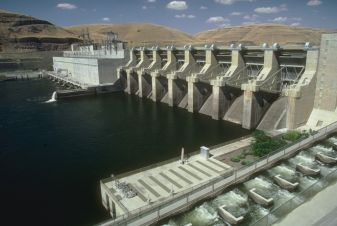forum
library
tutorial
contact

Don't Barge Into Court
Over Spill for Salmon
by Rick AttigThe Oregonian, April 13, 2010
|
the film forum library tutorial contact |

|
Don't Barge Into Court
by Rick Attig |
 The Obama administration should accept the independent scientific finding that even in this low-water year the feds should keep spilling water over dams
The Obama administration should accept the independent scientific finding that even in this low-water year the feds should keep spilling water over dams
The Obama administration is swimming against the current on the question of whether spilling water is the best way to get young migrating salmon and steelhead safely past the Snake River dams and on to the sea, even in a drought year.
If the feds stick with their plan to stop spilling water over the Snake dams May 1, they are almost certain to get swept into the courtroom of U.S. District Judge James Redden, who ordered more spill over Columbia River Basin dams in 2006 and generally has been pleased with the results.
This is no time for the Obama administration, which is now struggling to make an overall salmon protection plan strong enough to satisfy Redden, to tangle with the judge, independent scientists and fishery groups over the merit of a month or so of spill at the Snake dams.
That's an argument the federal government is not going to win, at least not right now, not with the 12-member Independent Scientific Advisory Board concluding that even in a near-drought year like this one, the best science argues for a "spread-the-risk" strategy that includes spilling water and barging fish.
That said, it needs to be clearly understood that the debate about whether to spill water, barge fish or both is about the best way to aid migrating fish in a low-water year. Some salmon advocates keep portraying the recommendation by NOAA Fisheries scientists to curtail spill as just another effort by the Obama administration to put electricity generation above fish protection. That's not what's going on here.
Government scientists contend that during low-water years, when the river slows and warms and migrating salmon and steelhead are more susceptible to predators such as other fish and birds, the most effective strategy is to capture as many fish as possible and barge them downriver past Bonneville Dam. During poor water years, the NOAA scientists contend, this "maximum transport" policy will lead to significantly greater adult returns of wild steelhead and chinook salmon.
The independent science panel disagreed. As its members wrote, "spill should be viewed as a default condition and that a mixed strategy of transportation and spill ... is once again the strategy most in accord with the available scientific information."
The region has only a few years of experience with increased spill, but some of the returns have been encouraging. Meanwhile, after two decades of hauling fish downriver it is well-established that larger numbers of barged steelhead "stray" into other rivers when they return, where they spawn and threaten the genetic strength of wild fish. Moreover, there's some evidence that spill strengthens sockeye salmon and lamprey eel populations, too.
The effects are confusing, and it doesn't help when pressure groups take legitimate scientific concerns such as the position by NOAA Fisheries scientists and portray them as little more than excuses to generate more electricity. The truth is that all the questions about spill and barging, especially during drought years, are not settled. But for now, as the independent scientists conclude, a mixed strategy is the best and safest approach.
Related Sites:
Independent Scientific Advisory Board
Review of NOAA Fisheries' 2010 Low Flow Fish Transport Operations Proposal
Related Pages:
Water Over the Dam Works for Salmon by Editorial Board, Seattle Times, 4/7/10
Time to Hook Some Chinook in the Lower Columbia by Mark Yuasa, Seattle Times, 4/10/10
learn more on topics covered in the film
see the video
read the script
learn the songs
discussion forum
